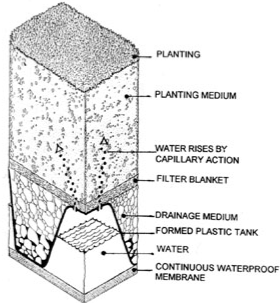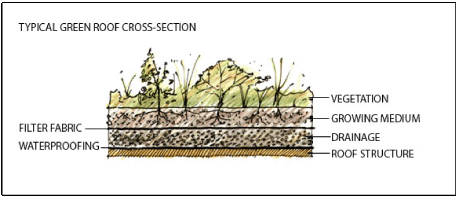

| Components | ||||
| Green roof technology replaces traditional rooftops with a series of engineered layers. The leading companies involved in green roof production and installation have developed their own patented products for each layer, but the concepts are similar across all companies. First, a water- and root-repellant membrane is installed over a new or existing, reinforced roof structure. Next comes a moisture retention/protection mat and drainage layer. Finally, filter fabric is installed to contain the growing medium. This growing medium is designed to be as light as possible for the plant type it is intended to support. | ||||
|
||||
| Green roofs, like traditional
roof surfaces, are layered systems. The most basic system consists
of a thin layer of growing medium planted with sedum, a succulent
plant. This system is installed directly over the waterproof layer
and has been successfully employed in Germany. Typically, however,
the plants are planted in about four to six inches of growing medium
over filter fabric and a drainage layer. Green roof systems may also
include layers such as root barriers, insulation, protective concrete
slabs, and irrigation systems.
|
||||
Vegetation For extensive roofs, the most successful vegetation will be drought tolerant, low-growing, shallow-rooted, and self-seeding. Plants adapted to life on high mountainsides and ridge tops generally work well. Sedums in particular have proven themselves very well suited to roof environments; other successful plants include grasses and wildflowers. In the Pacific Northwest, yarrow has been used with some success. Plant lists for both the U.S. and European markets can be found at www.greenroofs.com. For intensive rooftop gardens, plants and trees are generally chosen for their garden qualities. Most plants that would work in a small terrestrial garden would be an appropriate choice for a rooftop garden. |
|
|||
Growing Media Growing mixes vary, but will generally be lightweight and well-draining. This is especially important in extensive systems, which are often installed on roofs that have not been structurally reinforced. While intensive roofs often use deep, quality soil, extensive roofs will use nutrient-poor mixes that may have little or no soil in them. Mulch is often applied to the surface to retain moisture, cool the soil, and provide a continuous supply of decaying humus. Thin degradable mats or netting are used to prevent erosion and anchor plant roots on new roofs.
|
||||
Drainage Layer The purpose of the drainage layer is to convey water across the surface of the roof under the growing medium. The drainage layer may be composed simply of a lightweight, porous aggregate, such as pumice. Increasingly, however, drainage systems use some sort of plastic system that will support the weight above, but allow water to flow freely. Examples of such systems include Grass-Cel and other plastic grass paving systems. The plastic honeycomb pavers are designed for growing grass in areas of pedestrian or light vehicular use. In roof drainage systems, however, these pavers are left empty and turned upside down. Covered in a filter fabric, they fully support the weight of the layers above, while allowing water to drain freely. Other drainage systems incorporate ponding cells and are used in conjunction with the irrigation system. Water is held in small reservoirs and is drawn into the soil through capillary action. A wide range of green roof systems is available, but the basic function of all of them is the same: to support plant growth while allowing water to drain. |
 |
|||
|
||||

